
48 minute read
REGAINING THE LOSS OF A SEASON The Northern Alberta
REGAINING THE LOSS OF A SEASON
Their last show of the season was also the first, in what was the craziest year in the history of the Northern Alberta Reined Cow Horse Club. By Jessica Cline • Photos by Wildwood Imagery
Advertisement

Heza Duallin For Cash, owned by 7P Ranch, and sired by Heza Diamond Spark, rode by Dale Clearwater garnered the Stallion Incentive cheque.
Rewind to December 2019. The Northern Alberta Reined Cow Horse Club (NARCHC) ran their annual stallion auction to raise money for much needed club functions such as youth clinics, advertising, and member givebacks, as well as pumping funds back into their fledgling Stallion Incentive Payout. The board worked hard to present 26 stallions who offered something for everyone. There were a diverse mix of disciplines from rope horse sires, to upper crust cow horse and cutting stallions, and those located in both Canada and the United States. The aim was to offer a sire to everyone so as to grow the support for the club at all levels. The auction had been steadily gaining steam since its inception in 2015, and married the concepts of club growth and breeder incentive. It had grown to be the largest stallion incentive in Canada, reaching every corner of the club, as well as giving back to the stallion owner and the highest money earning offspring.
The first ever Stallion Incentive cheque was presented at this year’s event to Rider Dale Clearwater of Hanley, SK, who piloted Heza Duallin For Cash, owned by 7P Ranch, and sired by Heza Diamond Spark. This gritty show horse ‘earned money each time he was showed, and just kept getting better and better‘ according to Clearwater. He was sent to the Saskatchewan trainer in August of his two-year-old year, after being started by Owner Jesse Thompson. The entry received $1,227 to Clearwater and a custom Robin Hay Snaffle, while 7P Ranch garnered $732 for the Stallion owner portion.
Fast forward to March 2020. The very successful stallion auction had recently
Pure Latigo and Jonathan Morisson.

Strong Enuf and Shayne Smith closed and the club was ready for a record-setting year. However, in line with the rest of the world at the time – everything ground to a stop. The entire year was up in the air. According to NARCHC President Jocelyn Williams and longtime board member Dustin Grams, the largest obstacle was the fact that “you could not plan,” and anybody who has ever put any type of equine event on knows that proper preparation is key to success.
August 2020, five months into lock-down and summer riding is at its peak. Amid much discussion among the board, it was decided to attempt to offer a small schooling opportunity to the members. With proper measures in place, the event went off with excellent support. Now the board was in search of a secretary, as life changes seemed to be a challenge for anyone looking to fill the vital role in the organization. The search for secretary continued. Equine functions were slowly starting to occur, and tentative plans were put in place to host a year-end show in October – however what this would look like remained unknown.
Then in early September 2020, the yearend show gained National Reined Cow Horse Association (NRCHA) approval. Originally, contact was made to the NRCHA in January 2020 to investigate the possibility of the year-end show gaining the governing association’s approval. This option was explored to offer club members the opportunity to grow from the grassroots level and dip their toe in the larger pool of NRCHA classes, while maintaining the familiar atmosphere the NARCHC is known for. At the time, their proposal was rejected as the year-end show dates overlapped with the NRCHA Snaffle Bit Futurity in Fort Worth, TX, and it is written in stone that there are to be no approved shows to be held on these dates.
Further discussions took place once the yearend show was confirmed in late summer, and approval by the NRCHA was granted. Now, however, came the heavy lifting, as sponsorship acquisition and a secretary with NRCHA capabilities were still needed – and it was only five weeks until the first horse was slated to step in the pen. There were classes that needed discussion, rules that needed clarification, health and safety measures to adhere to, and all those little details needed to make a great experience for competitors.
If one word could describe this club, it would be “welcoming.” In doing so, the club has built itself a reputation of inclusion. This also meant members and club supporters were willing to give back and give they did. In those five week, $22,000 was raised, along with a mountain of prizes. Many new sponsors also stepped up, making the show a monumental success in such uncertain and economically difficult times.
In late September 2020 classes were confirmed and the entry package was released with three

weeks until start time. With the deadline looming, entries started pouring in and now the lategame organizational nightmare of running any show ensued. Decreasing physical contact also meant increasing the pre-event paperwork. Volunteers needed coordination and many newcomers needed questions answered.
The location of the event could not have been better. The Ponoka Ag Equine Center caters to every need either host or competitor. The show was held October 15 -18 and featured futurity, derby, and horse show classes and a showcase Saturday night.
SPECTACULAR SPECTACULARS
Horse show classes included spectacular classes which were sponsored by the stallion, Smokums Prize. As a twist, the board offered competitors the option to use their highest scores as use in winning tabulations. A new face emerged victorious in the Open Bridle Spectacular – Strong Enuf, a stallion owned by Keston Merrill of Bar Double M Angus in Hillspring, AB and his rider Shayne Smith were the champions.
“I picked the stallion up approximately six weeks prior to the show, and he had only been showed once previously in his career,” said Smith. However the owners wanted to see how he would perform. Strong Enuf is NRCHA World Show Qualified, and will stand to the public in 2021. Smith, along with wife Tressie, brought a number of customers thanks to the laid-back atmosphere of the show.
The Non-Pro Bridle spectacular was won by Coasting the Stars and Farrah MacArthur to the win. The horse also known as “James” performed double duty with son Waylon aboard in the Youth Rein/Box. Coasting the Stars is a family affair. According to both riders, he is easy to show, and is a big stopper. He steps up and carries Farrah to monster fence runs, then can throttle back and keep Waylon safe and in the correct position. The big palomino is worth his weight in gold. The family notes this show as one of their favorites throughout the year.
The hotly contested Novice Non-Pro Bridle Spectacular was won by Jonathan Morrison and his 17-year-old gelding, Pure Latigo. “Latigo” is described as laid back, and loves living inside a stall, but is a war horse in the arena. The Morrison family are NARCHC Year-End newcomers as they are typically finishing up combining at this time of year, however a smooth, early harvest meant they could make the drive from High River, AB. The whole family showed this year, with mom Robyn showing in multiple classes, and daughter Maysa in the Future Stars.
Deb Simpson’s smiling face was top of the leader board in the Non-Pro Rein/Box Spectacular. Her awesome gelding Devil in the Deep Blu, or “Token,” started their journey together in Arizona in April, when Simpson was on the hunt for another cow horse. This was her first young
Little Bellanita and Rick Wiebe.


Time for a Pepto Mint and Dale Clearwater.

Strong Enuf and Shayne Smith. cow horse, so she says ‘we are both still learning’. After a mistake in the Derby, they decided to enter the Spectacular, which proved to be a wise decision. She rode the wave of ups and downs, garnering a zero in the reining and turning around and scoring a personal best in the cutting over the course of the show.
The $1000 Limit Rein/Box Spectacular was won by Maria Murphy of Wetaskiwin, AB, on her “pride and joy” Peptos Peppermint, a 12-yearold gelding more famously known for being son, John’s, solid Non-Pro mount. The family has owned him since his yearling year, and campaigned him to his Supreme Reined Cow Horse Award, however now his duties include trail riding, and safely carrying the grandchildren. Maria has showed for two years at the year-end show, and appreciates the work done by the board to host such a wonderful and diverse show.
Winner of the Non-Pro Two Rein Spectacular was a long-time club member Ian Hryhirchuk of Irma, AB, on his solid daughter of sponsor Smokums Prize, Talkin Prize Money. This horse has shown in each phase of her career at the NARCHC Futurity & Derby show. Hyrhirchuk is a part owner of Smokums Prize, and has multiple offspring coming up by this talented sire in the next few years.
The Open Two Rein Spectacular was won by the chestnut powerhouse Peppers Pepto Lena, piloted by Geoff Hoar, Innisfail, AB, for owner Shawna Husted. This solid daughter of One Time Pepto has LTE approaching $25,000, and is simple and easy to show according to Hoar. He notes the growth of the sport at this show, which is evident with 23 youth among the various classes, and many new faces throughout. He also commented on the friendly, laid back atmosphere which made his youth customers feel less intimidated to give showing a try, and by all accounts, had fun doing it.
Speaking of youth, one of the largest observations were the sheer number of youth competitors at this show. Tyne Alliban of Carstairs, AB, emerged victorious in the Youth 13 & Under Working Cow Horse on her 14-year-old mare “Diva.” This was her second time going down the fence on cattle, and the brave girl said it was ‘really fun’, as she has mainly worked buffalo in the past, and her short pen made practicing fence runs difficult. This handy rider also won the Youth Cutting on Wild Haired Babe, her birthday present from two years ago. Alliban notes she loves the facility, and has also showed jumper ponies here in the past. The four-year NARCHC veteran says, “This club is great for kids who haven’t showed a bunch and there are classes for every level.”
In response to the number of grassroots riders, the board decided to offer a $1000 Non-Pro Cow Horse Spectacular. This class was won by Paint All-Around crossover April Milne of Sherwood Park, AB. Milne piloted her five-year-old mare Bagged A Dually, a stout daughter of Dually Cat,
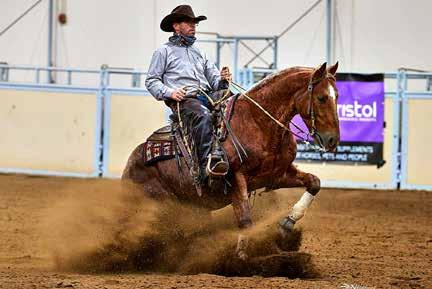
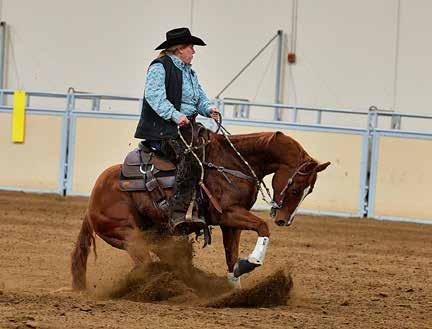
and her first cow horse, to the win. Cow sense is this smart mare’s biggest asset, but they have ridden the rollercoaster typical of young horses, with moments of brilliance followed by events where things quickly fell apart. The pair started in the entry classes last year, and are having fun going down the fence.
LIMITED AGE EVENTS
The trip from Sunrise Ranch, Outlook, Sk, to Ponoka proved fruitful for Rick and Becky Wiebe. Rick swept the Open Futurity divisions on the filly Little Bellanita, bred and raised by Red Spring Ranch of Okla, SK, and took home a tidy $3,365. The Wiebe’s purchased her as a later two-year-old, and were a little unsure she wanted to be a cow horse in the beginning. Things were starting to come together for the filly, but since all horse events were shut down early in the season, there were no opportunities to school and test her out.
“That fact can weigh on the mental aspect of being prepared,” says Wiebe. “But the most valuable lesson learned was to trust the work already done and not overthink things.She gets really deep in the ground, and is very consistent, making her fun to show,” he says. He is quick to thank his wife Becky for being his biggest support, and has the reputation of being the best turnback help around.
Speaking of wives, Dale Clearwater also credits his wife Terri as true owner of the Open Derby winner Time For A Peptomint. The horse is described as a ‘Steady Eddy’ who walks in and is the same horse time after time. “Horses with the ability to mark big, and are naturally big stoppers like this one are fun, and make my job easy” quotes Clearwater.
Limited open derby winner was Danielle Rosia’s horse Reminics Guns N Roses, guided by Clint Swales. They bested the field of nine limited open horses to an $1,800 payday.
On the Non-Pro side, the Futurity win went to long time competitor Clayton Hines of Drayton Valley, AB, on Jewels Are Heavenly. This duo walked away with $2,000 for the win. The Limited Futurity went to Jennifer Soltys of Marwayne, Ab, riding Madame Justice Pepto. Their win was accompanied by a paycheck totalling $1,150.
The Non-Pro Derby was won by the four-year old gelding Twist My Arm, for owner/operator Jim Dobler of Delburne, AB. This is a multigenerational product of their breeding program for Thunderstruck Ranch, combining ‘new’ sire Smokums Prize genetics with their hard-working Appaloosa mare, In The Nic of Sign. The product has a big motor when needed, but his laid-back personality has made him easy to show. Being a huge stopper, Dobler says his strongest event is the reining, as everything is easy for this horse to do. Jim loves the undercurrent of this show, noting it has the warm and welcoming atmosphere of cow horse in Canada of bygone days.
Jim Dobler and Twist My Arm

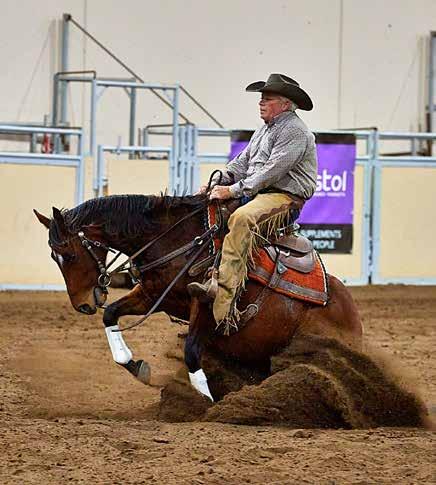
The Non-Pro Limited Derby winner was the four-year-old mare Ima Smokums Lena, also sired by Smokums Prize and out of Ima Jessalena. Shelly Holt, the rider of this talented mare, says she is very quiet and consistent, and is the fourth offspring of Ima Jessalena to hit the showpen. Holt was instrumental in developing the NARCHC Limited Age Event, which has seen rapid growth and currently enjoyed 45 entries. She appreciates the growth the event has seen, and notes its niche appeal. She understands the difficulty in balancing limited aged events with grassroots classes. – a feat which rarely happens successfully.
HORSE SHOW CLASSES
Lisa Allen, of High River, AB, veteran boxer but fence newbie, ventured out for her first time on her powerhouse CD Olena gelding Just Enough Shine. This show was her first, and she was excited to win the $500 Limit Cow Horse class. Mirroring this was Lin Irvine in the $500 Limit Rein/Box on her mare Trick E Niki. The 64-year-old appreciated the fact there was a place for everyone, and mentioned she was thankful for the live feed so her family could watch from the comfort and safety of home. Ranch Hand Class winner Victoria Johnson of Sundre, AB, was riding for Bar TT Cowhorses and won riding their homebred, Graceland Voodoo. She appreciated the constructive criticism and how kind everyone was to a new face.
The year-end show went off with rave reviews for all involved. Health and safety were balanced with great rides and good cattle, a fantastic facility and fun atmosphere, despite the cancellation of all social events. The exuberance that accompanies newcomers is refreshing to old faces, and the board does an excellent job of listening to the concerns of participants to make this horse show a highlight of the year. FUN FACTS OF THE NARCHC YEAR-END SHOW • Over 226 horse show class entries.

• 45 Limited Age Event entries.
• Champion and Reserve prizes were sponsored for all horse show classes.
• 437 head of cattle were used.
• $22,477 will be paid out in the Stallion Incentive over the next five years.
• Over 23 youth entrants.
Congratulations to the 2020 RAPP winners!

REINING ALBERTA PERFORMANCE PROGRAM “RAPP” RAPP is a local breeding program designed to enhance the existing Reining Alberta Sire Incentive Program. The goal is to increase participation and purses. The program was expanded to allow any foal to be nominated to the program. Foals sired by enrolled stallions will be eligible for nomination into the program at significantly reduced rates. The goal is to continue to promote the local stallions and have a program that will also benefit local breeders who choose to breed to other stallions.
3 yr Old Futurity - L4 Open Champion GUNNER IN THE NITE
Exhibited by Austin Seelhof • Owned by Outrider Ranch
3 yr Old Futurity - L1 Open Champion LIL LADY SNIPER
Owned & Shown by Renee Zakaluzny
3 yr Old Futurity - L4 Non Pro Champion SHOWIN MY SHINE
Owned & Shown by Shonda Day



4 Yr old Derby - L4 Open Champion SNIP OF JAC
Exhibited by Jesse Beckley • Owned by Norma Siebert
4 Yr old Derby - L1 Open Champion TINKERS NORTHERN GAL
Exhibited by Deb Duce • Owned by Southline Quarter Horses
4 Yr old Derby - L4 Non Pro Champion LIL GRAFFITI GUN
Owned & Shown by Wendy Williams



5/6/7 Yr old Derby - L4 Open Champion ONE GUN REMINGTON
Exhibited by Shawna Sapergia • Owned by Phil Heidebrecht
5/6/7 Yr old Derby - L1 Open Champion XTRA RUFF WIMPY
Owned & Shown by Christa Turel
5/6/7 Yr old Derby - L4 Non Pro Champion BB GUNNA TRASH TALK
Exhibited by Colton Wong • Owned by Julie Olenyk-Wong


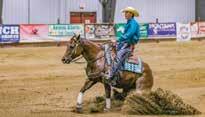
You must be a current Reining Alberta Member to nominate your foal. Nomination forms are available at www.reiningalberta.net and are due by November 30, 2020 RAPP 2020 Sires:
ALLTHATSHINES IS JOE Shauna Getz/Whitby Farms BERRY FINNOMENAL Nicole Klassen CHICS IN THE MALE Lynne Hoff COLONEL REMI Phil & Barb Heidebrecht BarHeide Invst. CRUSIN WHIZ Trueman Farms (Tammy Stewart) CUSTOM SMART SPOOK Robert/Lois Brickley
DUNITSMART THISTIME
Darrell Hanson
EINSTEINS CASHNCHEX
Ronja Schippers
HESA HOT GUNNER
Hollasch Quarter Horses
JOS NEXT TOP GEM
Karlie McKeand
JU JUZZ GUNSLINGER
Ranae Widney/Cassandra Day
LIL GUN (COLONELS LIL GUN)
Seelhof Perf. Horses
LIL JOE CASH
Gaylene Sawchuk - agent
LOKOTA CHIC
Brian Knutson/Bar K2 Ranch
MAJOR DURANGO
S. Gail & Robert Gatto - Jr. Stallion
MAMBOS WHIZ
Ken & Peggy Johnson
MR BAY ROOSTER
Lane & Sandra Giesbrecht
SHINERS BLACK CAT
S. Gail & Robert Gatto
SHINERS GOT SWAGGER
Sandy Corriveau
SHINERS LENA DUST
Ken & Peggy Johnson
SHINEY GOLDEN GUN
Brian & Vicki Braun
SMOKIN AMMO
Foothills Ranch
SPECIAL MADE WHISKEY
Gord Robinson (Big Rock Arena)
SPOOKS BIG BANG
Brian & Giselle Aebly
SUGAR CAT MAN
CD Quarter Horses
TEXAS TINSELTOWN
Locke & Deb Duce
WIMPYS FREE HUGS
Caflisch Quarter Horses
Enrollment Fees: Stallion fee $500/stallion/year • Deadline for stallion nomination is May 15, 2021 After May 15, 2021 late fees apply: Stallion enrolment fee $750/yr Reining Alberta www.reiningalberta.net
KEEP CALM & RIDE ON

Reining Alberta proved that with a dedicated team of supporters and a very willing membership, anything was possible in 2020. By Kathie MacKenzie • Tru Equine Photography
Jade Whitmarsh rode North Sail Solitaire to win both the Level 4 and Level 1 Non-Pro 4/5/6/7-Year-Old Derby.

It is no secret that 2020 hasn’t turned out the way any of us had planned. Fortunately, a lot of good things did manage to take place in the world of Reining Alberta.
Pre-Covid, Reining Alberta was actively planning a busy schedule with three Classic Shows and branch events around the province. Despite the lockdown and health restrictions, Reining Alberta kept in contact with its members and provided updates as they came available.
By the end of April, it was confirmed that most arenas, including Westerner Park in Red Deer, AB, were not going to be available to host our events. We made the difficult decision to cancel the Spring and Summer Classic shows but kept our hopes high and planning underway for the Fall Classic and Western Canada Affiliate Regional Championships (WCARCs).
In June, we started a Virtual Summer Series. The goal was to keep our members riding and interacting with their horses during the challenging days of the pandemic. Reining and Ranch Riding classes were offered for a minimal fee with prize money going back to the winners. Although the number of entries received was limited, the feedback from those who took part was excellent.

Renee Zakaluzny and Lil Lady Sniper won the Level 1 Three-Year-Old Futurity. They also received the special memorial buckle named after George Lauder.
At the end of June, Reining Alberta had secured the opportunity to host a schooling show at the end of July. We were completely grateful regardless of the restrictions to have a show. The turnout was fantastic and the feedback from everyone there was positive and full of gratitude. Everyone was happy to be at a show.
With a lot of patience and perseverance, we were able to go ahead with the 2020 Fall Classic & WCRACs. This show was not like other Fall Classic shows – it was four shows in one. We held the derbies and futurity from all three Classic shows, as well as the National Reining Horse Association (NRHA) Affiliate Championships for western Canada. With over 250 stalls booked, 194 horses from Manitoba, Saskatchewan, British Columbia and Alberta showed over the four days. Highlights included 110 entries in the Ladies & Gents class with Shayla Malmberg riding her mom’s gelding Megas Revolution to win over $400 on the first day of the show. Not bad for a schooling run!
The Non-Pros came out with high scores early in the show with BC’s Deanna Beckley on Whos Wicked Good scoring a 75 for the win and Manitoba’s Kyle Ryan scored a 73.5 on Maysons Little Spark for second place in the NRHA Non-Pro class on the Thursday night.
The aged events are always the highlight of the show and once again we were not disappointed.
Austin Seelhof (Cochrane, AB) with Marie Whitmarsh’s stallion North Sail Solitaire scored a 151 in the NRHA Level 4 Open 4/5/6/-Year-Old Derby on the Friday afternoon. Christa Turel (Olds,AB) showed her stallion Xtra Ruff Wimpy and took the win with a 143 in the NRHA Level 1 Open 4/5/6/7-Year-Old Derby.
The Four-Year-Old Open Maiden Derby (a class for horses with limited showing as a three- year-old), was won by Jaime Fischer (Chilliwack, BC) on Debra Phelon’s Shes a Royal Legend scoring a 147.50 to take home a custom buckle sponsored by George and Gail Lauder.
Jade Whitmarsh (Cochrane, AB) also rode her mother’s stallion, North Sail Solitaire and had a great run scoring a 146 to sweep both the Level 4 and Level 1 Non Pro 4/5/6/7-Year-Old Derby.
Meaghan Myers (Lloydminster, AB) and Smoking Mistress won the FourYear-Old Non-Pro Maiden Derby Buckle with a 138. The Non-Pro Maiden buckle was sponsored by Wendy Nelson Performance Horses.
This year’s futurity once again highlighted great horses and great riders.
Susan Strelioff (Calgary, AB) on her young stallion Dutyful won the Non-Pro Futurity with a 140.50 on the Friday afternoon. On Saturday, Austin Seelhof
took three of the top four placings in the Level 4 Open Futurity. He rode Outrider Ranch’s stallion Gunner In the Nite (by Gunners Special Nite) for a first place win with a 146.5. Hot on his tail, was Jesse Beckley of Cranbrook, BC, on his own stallion Mizzen Voodoo (by Shiners Voodoo Dr) with a 144.50.
The Level 1 Three-Year-Old Futurity was won by Renee Zakaluzny of Swift Current, SK, on her young mare, Lil Lady Sniper (by Smokin Ammo). This was an extra special win for Renee – as the owner of the winning horse in this class, she received a special memorial buckle named after George Lauder, long time member of Reining Alberta. George was a well respected owner and breeder of top quality reining horses and he loved the three-year old futurity. Zakaluzny had tears in her eyes when receiving the buckle and said it was an honour to have this keepsake named after George.
Once again, we have a great support system that made 2020 the success it was, despite the challenges we couldn’t control. Without our amazing sponsors, our volunteers, our stallion owners, our trainers, our exhibitors, the entire membership, the Board of Directors and our staff, none of our events would have come to light in 2020. From the bottom of our hearts, THANK YOU!
Planning for 2021 is underway and things will likely be different from how they were just a year ago, but what we will take away from 2020 is that “where there’s a will, there’s a way!”
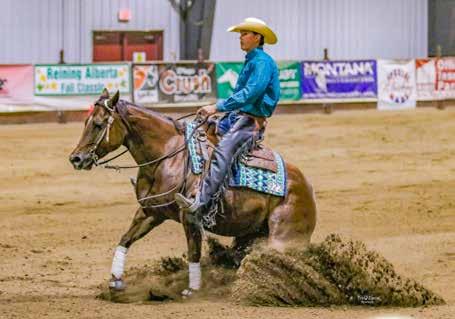
continued from page 58 had dissociated from the whole nightmare. To Billy, he was asking permission to unload after a great day together, to go have a drink and a roll, then tuck into his supper. The deadly switch had clicked back to neutral.
This was my moment of reckoning. On my back in the gravel, gulping down air and relief and the sour taste of shame, Billy and I had reached the end of our trail.
I have long wondered how this generous, sparkling, sunlit force of life could be crossed with such shadow. Had it always been in him? Was it how he was raised? What he’d endured, whether abuse or injury? A tumour or some imbalance in his brain? None of it mattered, once I saw that each of these questions lay outside me. None of the answers were mine.
Whenever I hear of a woman who finds herself, somehow, mired down in a bad relationship, I remember Billy. I think of how exciting he was, the highs he gave me on those good days. The joy that came from being with him, instead of wishing that I wasn’t still looking. Still alone. I think of the unholy terror that eventually forced me to see him for what he was. I have learned that always, horsemanship mirrors real life.
I have ridden that horse. I have trusted that man.
Lee McLean is best known for the storytelling on her Facebook page, Keystone Equine, and for her good ponies. One of eight women to race, sidesaddle, at the Calgary Stampede, Lee is resolved to write for, teach and represent other ordinary riders… the people who ride despite illness, injury, fear and changed plans! Her first book, HORSE WOMAN: Notes on Living Well & Riding Better, was just published and is available on Amazon. Lee lives with her husband, Mike, in the rolling hills of southwestern Alberta.

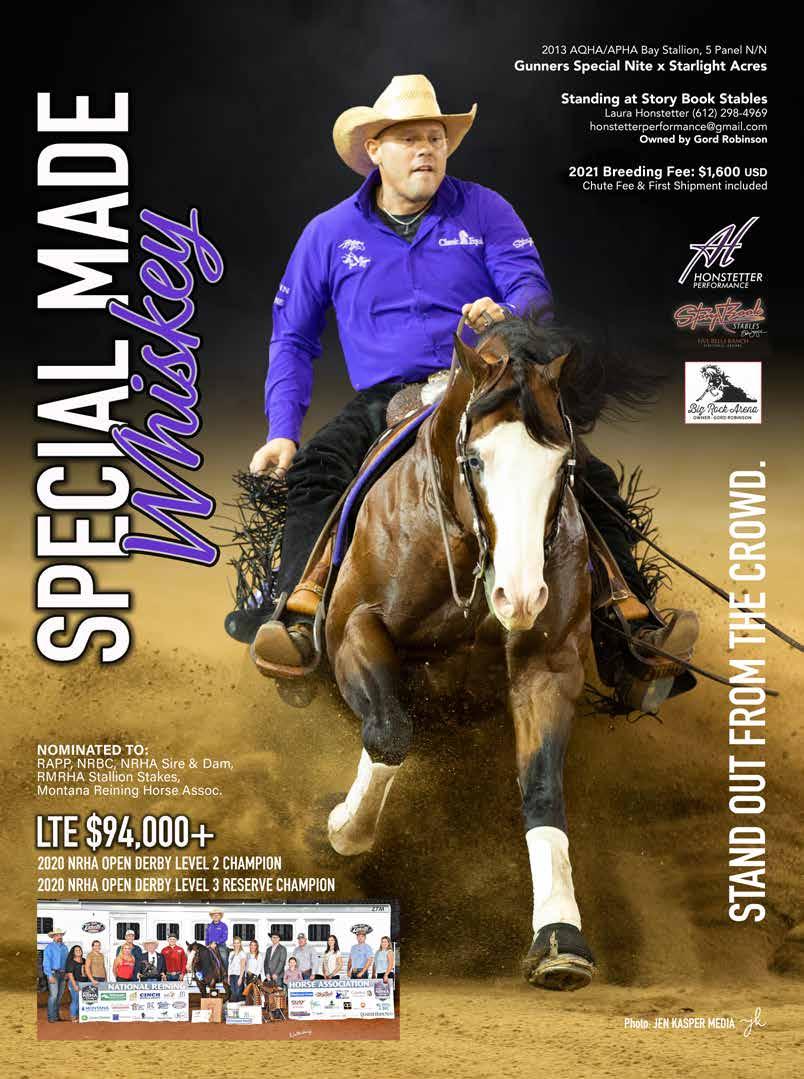
KICKING THE DUST UP

Highlights from the 2020 National Team Cattle Penning Finals. Story by Suzanne Hale • Photos by Lorie Inglis
Twin brothers Justin and Graham Armstrong, along with brother Russell, win the Open Shoot Out for the second year in a row.
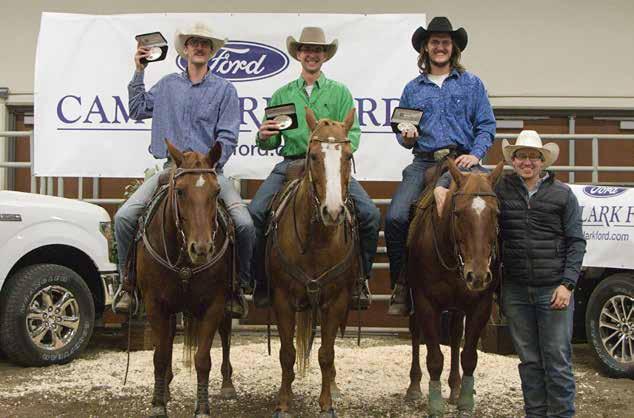
The 24th annual National Team Penning Finals, sponsored by Cam Clark Ford took place the weekend of October 10-13 thanks to a standout team of organizers, volunteers and contestants. In a typical year, participants have 12 months to fine-tune details, but 2020 was anything but. Once given the green light to proceed, organizers were left with a matter of weeks to bring the plan together. Drew Parker, a director with the Canadian 6 oversaw the COVID-19 guidelines together with Ray Antony, Chairman of the National Finals committee and representatives from the Calgary Stampede, Alberta Health Services, and participants with medical backgrounds.
A great deal of planning went into putting Covid protocols in place, including the implementation of a stand-by volunteer medical team, courier services to reduce the need to depart the grounds, disinfecting services and participant screening. While this year’s events resulted in reduced participant numbers and less prize monies, Parker notes, “The overall operation of the show was not affected. Compliance by all was excellent.”
Despite the lack of cross-border participants, the 2020 event offered high-level challenges and a respectable payout of approximately $325,000 which along with entries, was down about 25% from 2019, mainly due to Covid-related reasons. For the second year, and of even higher importance when many couldn’t watch in person, a live stream of the event was offered via Sort Arena.
“I’m expecting the stream to be a permanent fixture,” Parker says.
OPEN SHOOT-OUT
For the second year in a row, the BCbased Armstrong family of Russell and twin brothers Justin and Graham dominated the Open Shoot Out with a 93.67 time, which Russell notes was at least partly due to good fortune. “Every time you win, lots of luck is involved,” Russell
says, adding that there was undoubtedly a different feel to this year’s Nationals in the wake of Covid.
“No one was competing, so there weren’t many rating changes. Teams were similar to last year – payouts were less, but still very good. This show is still top of the line.” The downtime this year turned out to be a blessing for a family that’s perpetually on the move. “I love penning more than anything - I’d never have imagined I’d take a year off, but it was actually nice to take a breath.” Although the unexpected break was welcome, the Armstrong crew has no intention of stepping away from the sport any time soon. “You get a win, it hooks you – you want more!”
The reserve winning team of Sue Norquay, Ryan Conan and Nicole Sigouin posted a 101.52 time. Ken and Karen Mix of K&K Livestock, the Nationals show’s longest-serving sponsors, provided reserve champion winter blankets to all Reserve winners.
14 CLASS
Father and son Ben and Tom Thorlakson won with Open Shoot Out winner Russell Armstrong, finishing in 115.77. The Thorlakson-Armstrong history dates back to 2005, when the Thorlaksons stopped by the Armstrong ranch to discuss some business. The Armstrong boys happened to be in the middle of a penning-practice session and invited the Thorlaksons to join. “We’ve been competing together across North America ever since,” says Tom.
“This win was very special as it was with my father, and was my first win as a new dad to our perfect baby girl Sara Jane,” Tom says, adding that he had his wife Micaela brought Sara Jane down after their win to join the photo. “We had some lucky draws – cattle on the outside of the herd, and cooperative cattle that made it easier for us to have quick runs,” he says. “I strongly believe luck plays a key role in success, but if you’re not keeping your skills sharp, you’ll mess up some of the gifts the cattle will give you.” Tom competed on Peanut, one of his all-time favorites, while Russell rode his AQHA gelding Carl, who is highly regarded among Canadian penning competitors. Ben rode a mare he bought from Tom. “She works perfect for him,” Tom says.
Reserve winning team of Ryan Conan, Danielle Gamache and Sue Norquay were on the heels of the winners with a 118.01 total time.
8 SHOOT-OUT
Kiara Jones, Tanner Ruby and sister Brooklyn Ruby put together a 97.18 time for top honors in the 8 Shoot Out, while Rick Bond, Trina Dunn and Rene O’Rourke tallied 112.24, a scant 0.7 seconds ahead of
Four Days of action at the Nutrien Western Event Centre, Calgary, AB.

Tom and Ben Thorlakson, along with Russell Armstrong, were the 14 Class winners.

Tanner Ruby, Kiara Jones and Brooklyn Ruby were the 8 Shoot Out winners.

Kim Bayrack, Lissa Quinlan and Mac Wade win the 10 Class.

Darquise Beauchesne, Heather Stairs and Kirsten Scott were the 7 Class winners. the third place team for the reserve title. “We had good cow luck – they were either sitting on the sides or up front,” says Dunn, who won on her horse Lotta. “Stole her from my husband! She’s consistent and does her job every time – as long as I didn’t make mental errors then all you ask for is easy numbers to spot.” For Dunn’s part, the biggest Covid-related challenge was remembering masks. “If you were on foot, you needed a mask. I have two young children and their masks would go missing!” she says. Dunn noted that following Covid, she didn’t feel as prepared, but that also meant horses were healthy and fresh.

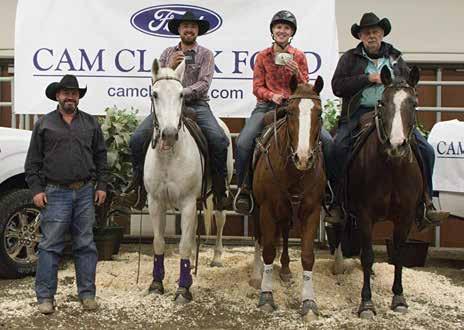
10 CLASS
132.10 seconds meant a 10 Class win for Kim Bayrack, Lissa Quinlan and Mac Wade, riding together for the first time at Nationals. In spite of a hitch during the second go when they couldn’t find the third rider, the other two executed a solid run, securing 10th spot. Quinlan thanks her horse. “I got this beautiful mare this spring – she never disappointed me! Nationals were amazing. Everyone was careful to distance, and clean often.”
Reserve winners, the Gamache family of Len, Danielle and Spencer did their last name proud with a time of 137.27.
7 CLASS
Top 7 Class honors resided with Kirsten Scott, Darquise Beauchesne and Heather Stairs, with a 128.75 time. Reserve winners Brenda Gilbert, Brittany Fraser and Rosie Zacharias finished in 135.19. Zacharias credits her ride. “I’ve had my mare Brumby for five years. She gives her whole heart.” Gilbert adds, “Spending a day on the back of your horse is a good day, but any time you can make it to the pay window is great!” Gilbert also notes luck was on the team’s side. “With 30 head of cattle, three horses and three riders – things can go well, or they can go really awful. This time, the cattle were positioned just right.” Commenting on Covid’s effect on Nationals, Gilbert says, “The biggest impact was on the spectators and on family who couldn’t attend.” Gilbert’s family, including an uncle who was in the hospital, took advantage of the streamed event. “They hollered at the TV! It was amazing to ride at this level during Covid. It’s always a spectacular show, but with the late notice and extra planning the organizers had to do – even more so.” Zacharias adds, “A huge thank you to everyone!”
5 CLASS
5 Class winners Emily Lomas, Justin Tetrault and George De Jonge found success with a 173.89 total time, while De Jonge and
Tetrault also took reserve honors along with Tammy Harmatuik with a total of 184.90.
De Jonge says all the runs were smooth. “The cattle were great, they’re always fresh. I’ve had my horse for six years and I may not be the best rider, I just hang on and go – but my horse knows what to do.” With Nationals being the first major equine event at the Stampede grounds following Covid, De Jonge expresses appreciation for the organizers. “I don’t know how they pulled it off,” says De Jonge. His Nationals history goes back many years, with a notable 7 Class win in 2011 with his daughter and granddaughter. “I’m just very thankful at my age to be taking part. We obeyed all the rules – keeping our distance, wearing masks – but once you’re sitting on your horse, you just go.”
JUNIOR YOUTH AND SENIOR YOUTH CLASS
Darryl and Randy Bruce teamed up with Clay Hunter, finishing in 159.01 in the Junior Youth Class with reserve winners, Cash Goodbun and Shaylene and Chase Hunter posting a 170.43 score.
Austin Bloomfield, Heath Davis and Leah Rycroft executed in 135.08 to take home a win in the Senior Youth Class, while reserve winners Chelsey Funk, Teagan Walker and Denise Greanya came in with a time of 137.16.
CENTURY AND A HALF CLASS
The Century and a Half Class winning team each took home a Tom Milne Memorial buckle with their time of 67.03. “Our cows were in decent positions to make quick picks,” says Laurel Harrison, who won with Perry Kelemen and Kevin Mcgillicky. Despite a season that didn’t allow for as much practice as usual, the team was pleased with the outcome. “We didn’t get any doubles or outside peelers, but our first run went smooth; we advanced to the final 10 in third place. Our winning run went even better – we had great chemistry and communication,” Harrison notes. “I’m honored to be on the winning team receiving the Tom Milne Memorial buckle.”
Miles Wright, Heather Stairs and George De Jonge found reserve success with a total time of 69.96.
Drew Parker rounds up the sentiments of many who were a part of the event. “I was humbled by how many of the participants came by the office, the barns, the trailers, to say thank you. This event meant a lot, to a lot of people who thought we would never pull it off. It was important for the health of anyone who participates at anything on the back of a horse.”
Austin Bloomfield, Heath Davis and Leah Rycroft were the champions of the Senior Youth Class.

Darryl and Randy Bruce rode up with Clay Hunter to win the Junior Youth Class.
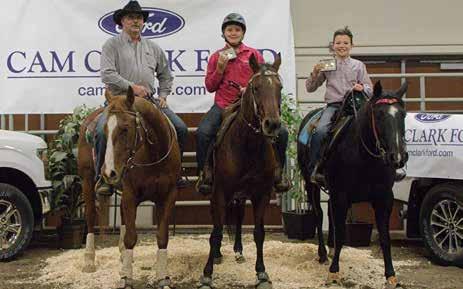

Chuckwagon Racing
THE WESTERN CANADIAN SPECIAL
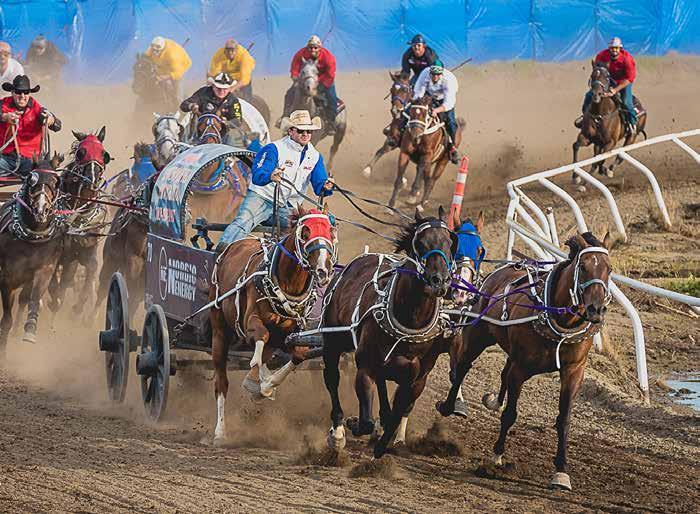
The future of chuckwagon racing is looking a lot different than it has in past years and it has many drivers wondering what the horizon looks like for them. Story by Kass Patterson
During a regular summer revenue drivers depend on, sponsorship and sport, my family and my horses.” across western Canada, winnings, and the loss of quality time with Four-time Calgary Stampede winner over 80 drivers and their family and horses. Drivers like Jordie and World Champion Kurt Bensmiller their families from three Fike (Blackie, AB) had to find alternate work (Dewberry, AB) said that one of the best different chuckwagon during the summer months to help support things about the sport is watching his girls associations would be setting up camp at the their families and feed their horses through grow up in it. various races across Alberta, Saskatchewan the winter. “It instills so many great traits in them. and British Colombia. This summer was “When you are gone working, you don’t They learn the responsibility and work that different as COVID-19 ultimately caused the see either one [family or horses] of them as it takes to care for the horses.” Bensmiller Western Chuckwagon Association (WCA), much,” said Fike who drives in the WPCA. added that they also learn people skills by the Canadian Chuckwagon Association “My wife was holding down things at home, interacting with other drivers, families, and (CPCA), and the World Professional and the few chances I would get to see them chuckwagon fans. Chuckwagon Association (WPCA) to cancel they were sleeping, and it was too dark out With the average WPCA driver looking their 2020 seasons. This meant the loss of to see the horses. I missed why we do this at around $100,000 a year in costs and
Four-time Calgary Stampede winner and World Champion Kurt Bensmiller says that one of the best things about wagon driving is watching his children grow up in the sport. Unfortunately, 2020 has not afforded him that opportunity.

Driver Jordie Fike had to find alternate work during the summer months to help support his families and feed his horses through the winter. He says he won’t be able to financially sustain two years in a row without racing.

associated fees, the career many choose because of their passion for animals and the sport comes with a hefty price tag. Drivers depend on the sponsorship money they get during the season, and any possible winnings they earn goes towards caring for the horses during the offseason. According to Fike, his family can’t financially sustain two years in a row without racing. “Even just to get the feed this winter is a stretch, and maybe putting us in a bit of a tight spot,” said Fike. “But we just can’t just can’t do this two years in a row.” Bensmiller adds that the loss of the season could change the landscape of wagon racing due to the possibility of drivers having to drop out because of the financial strain of 2020. Bensmiller said he thinks it will be the up-and-comers who survive these uncertain times. “It is the more established guys who I don’t think can weather another season without racing, the guys who are just starting out I think may have a better chance.” Bensmiller explains that drivers have a lot of money put into their chuckwagon racing outfits, and a lot of the investments they make are chuckwagon racing specific, and the sport’s revenue and value aren’t just in the Thoroughbreds that pull the wagon – but the wagons themselves. A new wagon can cost a driver up to $20,000 and without wagon racing or somewhere to run wagons, all of that equipment and the investment drivers have made in the sport and their barns become obsolete. Things like a driver’s trailer, their wagon, and other pieces of tack are created and designed specifically for the wagons. You could say the same about many of the horses. While there are other opportunities out there as polo horses or jumpers, most of these equine athletes’ job and purpose is to be hooked up with three other horses to a wagon, competing with their friends on the racetrack. For example, Bensmiller’s good right leader – who has led him to multiple victories – worth lies within the racing community; he doesn’t have the same value outside of the community because he isn’t a horse that you can saddle up and ride. Bensmiller explains that this horse’s job and purpose is to pull a wagon, it is a job that he loves, and when his career is over, he will be retired on his family’s property to live out the rest of his days. Finding a horse’s place on a chuckwagon team means that the drivers and their families need to spend time with the horses. It’s working with them as often as possible for some drivers, while for others like Fike, it means pail feeding them every day. “A guy gets caught up in his daily routine in the winter, and he might miss something. It is a reason to get close to them and feed them a pail of oats every day.” He explained that going out into the field and feeding them directly allows him to see the horses, how they interact and get an idea of where they should go on the wagon. He said that it also allows him to see how the new horses get along with the veterans, learn their personalities, and make sure they are healthy and safe. For most drivers, autumn is when they would be horse shopping at Thoroughbred racetracks across North America. It allows them to fill any holes they have in their roster at the time and think about the next year. With the way the current wagon landscape is though, most – if not all – drivers are opting out of horse shopping this fall, choosing instead to focus on their existing team. Bensmiller said this is the first time in his career that he isn’t shopping for horses.
“Most years, I bring back a trailer load full of horses, but with the questions that are still in the air, it just didn’t make much sense this year,” said Bensmiller.
EMBRACING AN UNCERTAIN FUTURE
The loss of the 2020 season, while causing some strain financially on drivers and some changes in the sports landscape, also gives the sport a chance to reach a new demographic and evolve while staying true to its heritage. “Any sport has to keep up with the world, and the way the world was changing, we have to modernize our sport,” Fike said. Over the past 20 years, there have been multiple changes made in the sport; from eliminating the tent posts and going from four outriders to two in shows like the Calgary and Ponoka Stampede’s, to updates in horse care and safety protocols. Animal care and safety are top of mind for the drivers, their families, and all involved in the different associations. In September, the Calgary Stampede announced the changes they were making to the Rangeland Derby in 2021. These changes included going from four drivers per heat down to three, dropping the invite list from 36 drivers down to 27 – cutting nine eligibility spots. The Stampede is also adding a collapsible arm to the inside rail. In their press release, the Stampede said that these changes are for the safety and betterment of the sport. Another change made is that WPCA drivers will be the only ones competing at the Stampede come 2022. That decision has been the subject of scrutiny online, but both Fike and Bensmiller stress that the important thing is that all three associations are healthy and thriving. Fike and Bensmiller have ties to the CPCA, with Bensmiller being a CPCA baby (his father and grandfather both competed in the association), and Fike starting his CPCA career there. Associations like the WCA and the CPCA allow new drivers to begin their careers and compete while also giving them a chance to work during the week because travel in both those associations is less than the travel that in the WPCA. “I didn’t have the horsepower in the barn when I first started racing, but I was able to build up my barn in my years on the CPCA,” said Fike. “When the time came, I was ready to compete in the WPCA.”
Kurt Bensmiller (left) and Jordie Like (right) are competitors on the track and friends in real life.

Looking at the WPCA roster, close to 90% of the drivers now racing in the Worlds started their careers or spent time in the other two associations. During a regular season, the drivers in the WPCA racing close 50 nights from June to August, with travel in B.C., Alberta, and Saskatchewan. In comparison, drivers in the WCA run around 20 nights during the summer and travel within Northern Alberta and BC. Finally, drivers in the CPCA run approximately 30 nights during the summer and travel around central Alberta and Saskatchewan. Making a move to the WPCA for some isn’t feasible or possible at this time, but that doesn’t mean they don’t love the sport and aren’t competitive, they are simply focused on what is best for their families and their horses. No matter what association a driver is competing in, a constant is the need to connect with fans. Chuckwagon racing is unique because the horses are the show’s stars that people are coming to see. A wagon would not go around the track without the four equine athletes pulling it, so with that being said, the sport is working on their connection with fans. “We aren’t like other sports where you come off the track and can go to the concourse and interact with fans right after the races,” Bensmiller said. “The number one priority is the horses, and once we are done on the track, our focus is shifted to cooling the horses down and taking care of them.” Bensmiller explains that while some drivers and their families have one or two employees come down the road with them, that doesn’t mean they get to pass the horses off. Drivers are hands-on with horse care from morning chores to evening feed. This cuts back on their ability to interact with fans and the public. Fans don’t get to see the work and the horsemanship that goes on behind the scenes in the barns. The use of social media is bridging that gap. Even with the cancellation of all sanctioned events in 2020, a charity Fun Run took place in Saskatchewan and Dewberry, Alberta, this year following each governments’ COVID-19 guidelines and restrictions. Drivers from the WPCA and CPCA competed in the races. However, it wasn’t just the drivers who showed up to these events – the fans came out as well. The number of fans who showed up to watch the at-a-distance shows the love for the sport is there, and the support is too. As we head towards the 2021 races, there are plenty of questions in the air, but the one constant is the love that drivers, families, friends and fans have for the equine athletes that make up the sport.
Billy.
This thing between us began as pure love. We met and I was knocked sideways by the force of Billy’s personality. When I first brought him home, our herd silently parted like a pool of water while the cocky horse waded right through. They knew something I did not. Thus, Billy became the boss hoss and all the while, he was smiling.
Story and Photos By Lee McLean

Riding Billy was euphoric. A small dynamo, he was as handy as a deep pocket. Full of energy, the little bay could work for hours. Never had I been on such a horse to sort cattle. Sweeping left, then right, a gathering move, heading up a pushy cow, everything was effortless. I grew used to being ‘the gate man’ no matter where we’d ride. Yes, it felt good to be this ageing ranch wife, handling this horse in a land of Marlboro men. They, who still call the shots, so grudging with their respect.
Mike started hauling Billy to brandings. I’d watch the trailer leave with my new horse, proud and hurt, all at once. They’d return home, tired but happy, Billy working like a machine and Mike missing very few loops. Then, one night, a change.
“He bucked me off in the branding pen,” said my sheepish husband. This, for the uninitiated, is the cardinal sin in a good ranch horse. Branding pens are crowded, bustling places for the serious business of vaccinating, castrating and recording the year’s calves. People are rushing around on foot, there are ropes between horses and cattle, along with all that represents one family’s livelihood. Bottom line, bucking is not allowed.
Excuses were made. Perhaps the rope came hard across Billy’s hip, or under his tail. Perhaps he was just sore from a long season. Life went on. I forgave and forgot.
Our immediate family kept a small herd of our own cows separate from those of the main ranch, a sort of savings account. One June evening, we were down at the pen beside the creek, our cows gathered and bawling, the calves healthy and ready to treat. I remember smiling as my daughter prepared to do the roping on Billy. She would heel the calves, while the rest of us would wrestle, brand, castrate, vaccinate and put in ear tags. We made for a small but efficient crew.
All went well until the last calf.
He was duly roped, the dallies were made and my daughter reined back toward the wrestlers. Without warning, Billy blew apart at the seams. After losing his rider, he bucked overtop my two sons who were down holding another calf, then he knocked over the branding pot that held the fire. At one point, all three of my grown children were lying about the pen, hurt, stunned, while the rest of us raced to stomp the spreading flames. All of this, while avoiding the violently bucking horse. Luckily, our injuries were minor – bruises noted, tried gingerly, joked about, shaken off.
Excuses were made. Perhaps the rope… perhaps he was sore… perhaps. I made things right by taking much of the blame.
My family began to voice their doubts about my new horse. Discussions were held, though I refused to listen. I felt that Billy was genuinely sorry whenever he lost control. Strangely, he himself, was never frightened or upset by his outbursts. It was as if I had two different horses. He’d be lovely for months on end, kind and affectionate and my word, could he perform. Despite these foibles, I never felt unsafe with him. Rather than focus on problems, my mind would stick resolutely to our good days. And so, another year passed, all the seasons made beautiful by riding a top horse.
One golden evening, Billy and I pulled into our yard after a long day’s work at a neighbouring ranch. I greeted him happily as I swung open the stock trailer’s door. Usually, my horse will be hauling loose, turned around and watching me from the front, ready to be asked to unload. But not this time.
Billy stood as in a trance, his head to the far corner of the trailer, unmoving.
I waited and called out to him, “Hey, buddy. It’s time to go have a roll.” Nothing. No blinking, no breathing, a horse carved of stone. Without thinking, I walked in and put my hand on his shoulder. I remember hearing the sound of the trailer door swinging closed behind me, the ‘snick’ of the latch clicking shut.
Billy woke up. Suddenly, my horse was a stranger, a panicked whirlwind of hooves and flying snot. In his nightmare, he seemed to be drowning. Survival meant climbing onto the only solid thing he could find. Me. As long as I live, I’ll not forget the crashing and sparking of his shod hooves on the walls of the trailer. The bouncing of the floor, the banging of his head on the metal roof and the jingling tie rings, as I tried to stay at his hip, away from those lethal front feet.
I made it to the bulkhead of the divider, a mere six inches of aluminum, to escape the worst of his blows. I knew that the big door was firmly shut behind me, a good eight feet from where I stood. Could I make it all the way to the back corner and the door latch? Would my fingers remember how the slammer worked in that last moment before my horse took my life? In the middle of this panic was a calm sense of knowing that I was done for. I was alone with my killer and nobody would be coming to save me.
In the end, I made a rush for the door at the same time Billy landed on his halter shank. It was the two-second pause that I needed. I threw open the door and fell backwards onto the ground, my stomach heaving with the sickness that comes after adrenaline’s rush.
There was silence in the trailer, some heavy breathing, one quiet footstep... and then, another.
Billy’s sweet face peered out at me, a hank of black hair shading his eyes. “What are you doing down there?” he asked. With a shock, I realized that once again, he continued on page 48
HAZARDS IN PLAIN SIGHT
The farm and ranch community are inherently proactive and aware that hazardous atmospheres exist. However, these conditions continue to remain in traditional and non-traditional workplaces and are often ignored with catastrophic results.
It is the lack of training and experience for those working in a potentially explosive atmosphere that is creating the likelihood for disaster in seemingly safe environments. At CANARY, we are part of the ground-floor hazardous locations awareness planning that enables companies to ensure that their operations are functioning safely and that old and new explosion risks are properly addressed through education.
HAZARDOUS ATMOSPHERES EXIST WHERE:

Explosive gas atmosphere is present in the air in quantities that require special precautions for the construction, installation, and use of electrical equipment Dusts and Grain Dusts are present in the form of clouds or layers in quantities that require special precautions for the construction, installation, and operation of electrical equipment
CANARY HLE IS DEDICATED TO CREATING AND SUSTAINING SAFE WORKPLACES
OUR SERVICES
Training • Consulting • Hazardous Area Classification • Certification or Design Assistance for Flameproof, Intrinsically Safe Electrical Equipment





